
 |
| 1.1.3 |
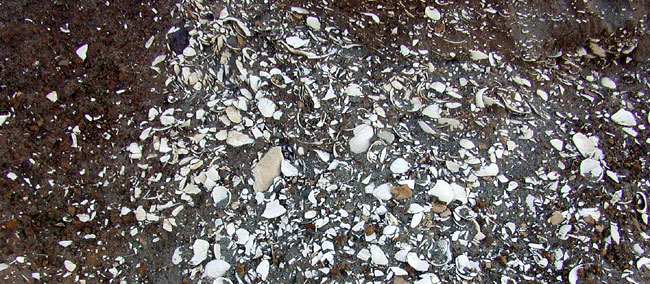 |
Native American kitchen midden (Morro Bay, California) showing shells of seafood consumed by these early cultures. (GA image) |
| Early man began to interact with the oceans where sources of marine life were some of the main food items for cultures living near the shore. The remains of many of the marine organisms that were eaten are found in their kitchen middens and show us not only what they ate but give us an idea of the species and their abundance during that particular period of time. Also, we know that these food items were most probably easily attainable along the shore. Since there was no written record during this time the presence of shells in the middens gives us valuable information about what types of marine life were abundant at that time. |
 |
Greek architecture remains today as a distinctive influence with columns. This is the top of a mausoleum (dated 30-20 B.C.) near Glanum, France. (GA image) |
| The Phoenecians and Greeks, in 2,000 - 400 B.C., were some of the first known explorers to leave their local communities bordering the Mediterranean Sea. They went outside the Mediterranean to the Atlantic Ocean with their knowledge of tides, currents and seasonal changes. Although they developed a large amount of marine science knowledge, this was lost until after the dark ages. |
 |
Viking ship in museum in Oslo, Norway found under a burial mound in southern Norway. (GA image) |
| The Vikings, in 700 -1000 A.D., developed distinctive open boats and explored the North Atlantic from their Scandinavian homelands. They reached Iceland in about 700 A.D., Greenland in about 995 A.D. and North America around 1,000 A.D. In order to do this they had to develop detailed knowledge of currents, winds, tides and ocean phenomena - thus they can be considered "marine scientists." They established a colony in North America but it eventually failed probably because it was not self-sufficient and the weather became much colder during this time (preventing the open boats from bringing supplies). They are thought to be some of the first (if not the first) settlers in North America. |
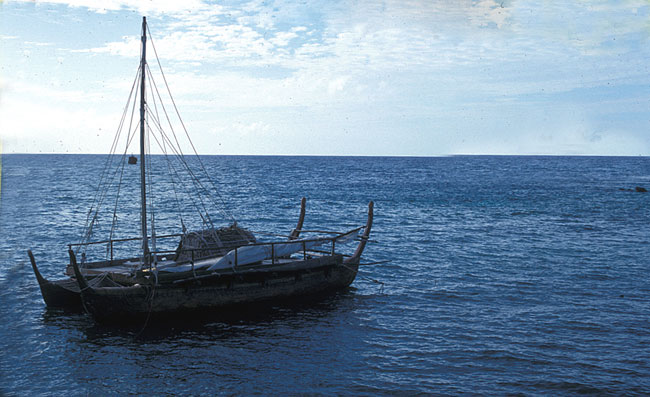 |
Reconstructed Polynesian boat touring South Pacific in 1995, Cook Islands. (GA image) |
| The Polynesians, 300 - 1500 A.D., used natural phenomena to migrate around the South Pacific in boats much like the reconstructed one pictured above. War in the islands of southeast Asia during this time seemed to be the reason for a scattering of Polynesians across the South Pacific. They colonized islands west of Samoa, New Zealand, Easter Island, and Hawaii (perhaps even South America). |
|
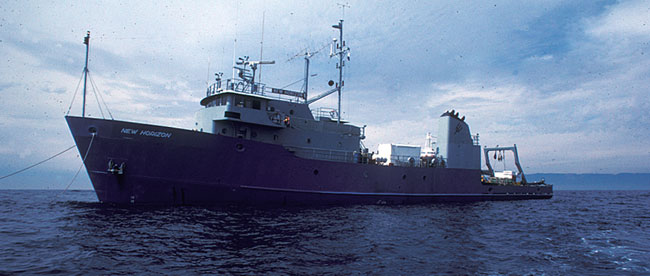 |
Research Vessel, New Horizon is owned and operated by Scripps Institution of Oceanography. It is often hired by other Universities to conduct scientific expeditions. Notice the 'A-frame' on the back (the big square) which allows scientists to deploy and retrieve large pieces of oceanographic gear. (GA image) |
| The Age of Scientific Expeditions overlaps with 'The Age of Discovery' as voyages were organized purely for scientific purposes rather than the usual military voyages with a focus to claim territory. The United States Exploring Expedition (1839-1843) under Charles Wilkes was shrouded with political, military, and personal problems. Several ships were used but not specifically converted for scientific purposes. Although it was a very important marine expedition it has gotten little attention by marine historians because of all the problems. It was this expedition that travelled 90,000 miles around Earth's Oceans, confirmed the presence of the continent of Antarctica, discovered many Pacific Islands and charted much of the Pacific Northwest. The results of this expedition (specimens and written accounts) were some of the first collections in the United States Smithsonian Institution. Over 50,000 specimens were collected representing 10,000 species. New charts (totaling 241) were produced including many areas of the South Pacific islands (especially Figi), the coast of Antarctica, and the Oregon coast. The importance of this expedition is just being recognized today and many books still do not even record it. The Challenger Expedition was the first expedition that was purely for marine science. Mostly funded by the British, it took 3.5 years (1872 - 1876) to investigate deep-sea regions of all the major ocean basins. The ship itself was converted for this scientific purpose from a wartime ship with sails and a steam winch. It was the first government funded, non-military ocean expedition. Results from this expedition included 715 new genera and 4,417 new species, the deepest depth of the oceans found to be in the Mariana Trench (still the deepest), 50 volumes of information published in the British Museum and the word 'oceanography' used for the first time. The Glomar Challenger Expedition, in 1968, proved the theory of plate tectonics by developing the technology for deep-sea drilling. The samples from this United States expedition focused on the ocean bottom and provided specimens and data to substantiate the theory of plate tectonics and continental drift. The Glomar Challenger ship was built specifically for this purpose with a specialized drilling rig in the middle (with 10,000 meters of pipe), engines to position the ship sideways and rotate it, and new satellite navigation equipment and computers. Research vessels are expensive to build, maintain, and upgrade with the latest technology. Today most research vessels may be sponsored by a particular country and agency but are used by a variety of universities and researchers from around the world. Many cruises (expeditions) nowadays involve professionals from a variety of disciplines and countries in collaboration to get the maximum use from a research vessel cruise. |
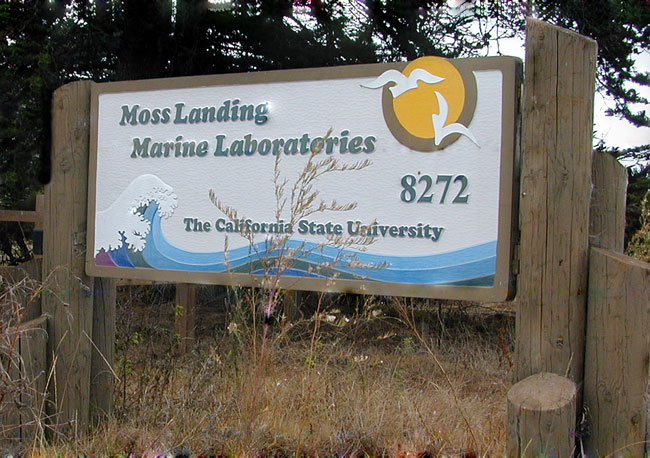 |
Moss Landing Marine Lab is in central California, near Monterey. This marine lab has courses and research for students from six California State Universities. (GA image) |
| Marine Labs began as a place for marine scientists to process their specimens from expeditions and conduct additional research. The first marine lab was probably started in Italy around 1872. Others followed in England (1879) and in the United States at Woods Hole Oceanographic Institution (now WHOI but under other names before) in 1888. Other important early marine labs in the United States were started in Monterey, California by Stanford University at Hopkins Marine Station, in San Diego, California by the University of California at Scripps Institution of Oceanography, and in the San Juan Islands, Washington by the University of Washington at Friday Harbor. Today these marine labs continue to be centers for marine science and many more marine labs have been built all over the world by various universities to support their marine science programs and provide a place for researchers to work. Many marine scientists arrange to use marine labs all over the world in a cooperative manner. Most of these marine labs provide some type of community outreach as well as focused research. |
| Technology has changed marine science over the years. Sonar (Sound Navigation Ranging) was a big scientific advancement which was developed during World War II for use with submarines. This allowed humans to 'see' the bottom and other solid objects underwater as sound was transmitted from a vessel with its reflection received and translated into a profile of the ocean bottom (or midwater object). Its initial use was for the military but it became one of the main tools used by marine scientists to profile the bottom of the ocean (as a fathometer) and outline organisms in the water column. |
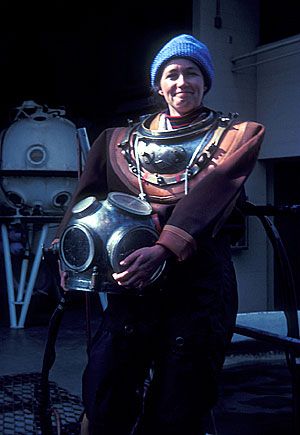  |
Hard hat diving (also called 'heavy gear') was one of the first types of gear with communication topside. The author, Genny, was taught this type of diving in 1983 at the SBCC Marine Technology facility, left. Students can get training in commercial diving through the Marine Technology Department at SBCC. The diving bell at SBCC right. (GA images) |
| Visually exploring the oceans was enhanced with the development of scuba diving (self contained underwater breathing apparatus) which allowed humans to descend to 100 to 200 feet rather easily. Helmet diving (with communications to topside) developed with various mixes of gas, allowing divers to descend deeper and stay longer. Diving bells were developed which allowed divers to enter and exit the bell while staying at deep depths (inside the bell divers could live comfortably). Scuba, helmets and bells subjected the divers to changes in pressure and physiological changes that had to be carefully monitored to avoid death. |
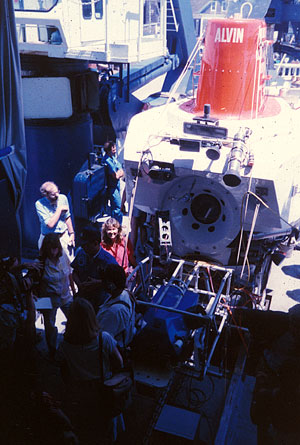  |
Submersibles like the Alvin (left) and Gamma (right) allow scientists to descend to deep depths and stay for long periods of time. Image on the left was taken of Alvin the day before the expedition left that successfully found the Titanic. Note the blue instrument (about four feet across) on the front of Alvin. This is Jason, an ROV that operates from Alvin and can be driven into tiny spaces. Jason took many of the photographs of the Titanic. (GA images) |
| Submersibles were built like small submarines to take marine scientists to even deeper depths and keep the divers at one atmosphere pressure to avoid the physiological complications associated with scuba, helmets and bells. The first models could hold several people (usually a submersible pilot and one or two passengers), had small ports (maybe only a foot across), allowed limited visibility but allowed marine scientists to actually see and photograph the deeper portions of the ocean. Submersibles like the Alvin, run by WHOI still operate for deep-sea exploration today. |
  |
The JIM Suit (left) and the Newt Suit (right) were developed to allow a single diver to 'walk' on the bottom. (GA images) |
 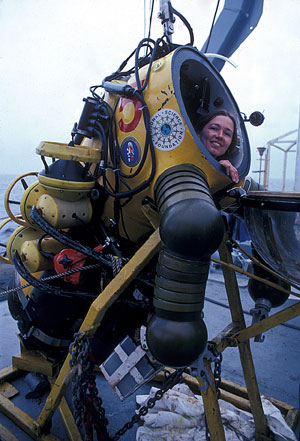 |
The WASP submersible was developed for the oil industry and first used by scientists in the Santa Barbara Channel in 1982 (left). The author, Genny was friends with the deep-sea scientists who did this and was given a chance to get inside the WASP (but not dive it) and take pictures (right). (GA images) |
 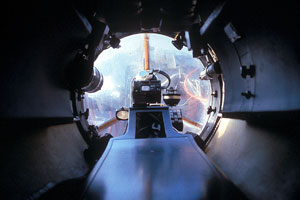 |
The MANTIS submersible was also used by oil companies as well as scientists. (Image, with permission, from Carter Mitchell) |
| New types of submersibles were developed to have only one passenger and better visibility with 180 degrees of vision using strengthened 'bubbles.' These all kept the diver at one atmosphere pressure (just like the larger submersibles) to allow deep dives for extended periods without physiological complications. Some of these include the JIM and Newt Suit with movable legs to walk, the WASP - used by scientists in our channel without movable legs but working in an upright position, and the MANTIS where the operator is horizontal. |
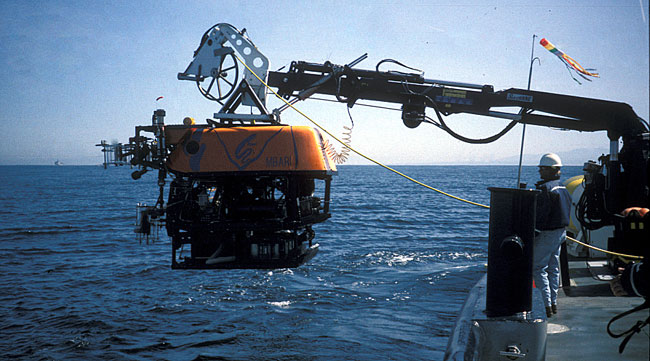 |
An ROV being deployed in the Pacific Ocean by the Monterey Bay Aquarium Research Institute (MBARI). (GA image) |
| ROV's (remotely operated vehicles) are now used with and without submersibles to view deep areas of the ocean without the dangers of sending humans down to these depths. The ROVs carry all types of cameras and sampling equipment. These have become the latest technology for viewing the ocean. The images from the ROV cameras are transmitted to the vessel overhead and the ROV operator (on the vessel) can maneuver the sampling equipment and cameras to the best positions. Images of the deep ocean are instantly seen at the surface and recorded. Remote sensing using transmitters and satellites now allows information to be gathered from almost any place. Transmitters placed on seals, sea lions, and whales send information when the organism surfaces as to the depths of their dives, the temperature of the water, and other things. This information is bounced from the satellite and picked up almost instantaneously so that the location of the organism and its information is known. The same thing occurs from buoys placed in the ocean where periodic measurements of temperature, wind, currents and such is transmitted. Satellites can also be programmed to send almost instant monitoring of the oceanographic conditions all over the world including sea level and color. Computer technology is built into many of the advanced marine science instruments (diving equipment of all kinds, submersibles, ROVs, satellites) and allows scientists to easily analyze their data as well as to communicate. |
 |
Students in Marine Biology class at Santa Barbara City College collect data on sandy beach species at Leadbetter Beach (across the street from SBCC). (GA image) |
| This is an exciting time to be involved with marine science - as a career, beginning student, or general member of society. Marine labs are often working with education and outreach programs in their local communities. There has been a change in the focus of tourist aquariums where marine education is a primary goal instead of the adventure park themes. Over centuries of time the ocean has become a source of wonder and great interest. Marine Science has expanded into many specialized fields which can be categorized as physical (often called oceanography) and biological (often called marine biology). Each of these has specialized subdisciplines - in oceanography there are the marine geologists, marine chemists, marine physicists, and physical oceanographers - in marine biology there are the marine algologists, marine invertebrate zoologists, ichthyologists, marine mammalogists, and biological oceanographers. There are many more subdisciplines and many overlap (for example the biological oceanographer spends a lot of time with physical oceanography as well). The physical marine sciences focus on aspects of the ocean that are not usually oriented to life forms whereas the biological marine sciences focus on the life forms. But, both are closely tied together and influence each other. Since the beginning humans have always tried to explain their environment and when it involved the ocean it became part of marine science. Throughout history humans have added to this body of knowledge about the oceans so that today we have a huge body of knowledge to draw from, including many laws, observations, and reasonings. But, there is still much to be discovered - some people say we know less about our ocean bottoms than we do about our moon. Many scientists have used information gathered about the oceans and planet Earth to try to explain how the Universe started. All disciplines have been tapped to develop a plausible explanation although the physical disciplines (chemistry, physics, geology) have been used the most. This 'theory' is substantiated by observations and measurements taken by scientists and is considered to be one of the most plausible theories today. It can be summarized as "The Big Bang Theory" and is the focus of the next lesson. |
(Revised 3 December 2008) |